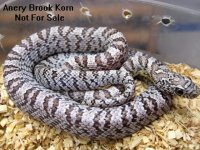A long while back I used to be VERY interested in the neotropical triangulums and even deluded myself into believing I could acquire at least a pair of all the variations that were at that time "identified". I bought every paper and publication I could find about them and studied what the people who were supposed to be experts wrote about how to actually identify them. And the more I "learned" the more obvious it became that these various subspecific races of triangulums were about the most glaring example of arbitrary hair splitting that I have ever seen. Locality ranges overlapped, triad counts had variances that overlapped, scale counts covered wide ranges that upper and lower counts of any subspecies would overlap one or more others, etc., etc. I asked people questions who were supposedly in the know, and they either dodged the pointed questions or made replies that were nonsensical in the arbitrary nature of how those lines are drawn identifying one subspecies from another.
For decades, triangulums were collected from all over the ranges of all the subspecific types, and exported from whatever country of the day had current licenses to send those animals to ports in the USA. So importers would go through all of the milk snakes that came in and arbitrarily label them as they THOUGHT they matched with their interpretation of what made any particular subspecies of triangulum. This was all well known to those interested in these animals, and even back then, the purists of the day claimed that the ONLY way you could be certain of the subspecies you had in hand was if you actually collected the animal personally within the range that someone stated that it came from. Point blank, NO ONE could just pull any of those subspecies out of a bag from "locality unknown" and know positively, beyond any shadow of a doubt, what it was they actually had in their hot little hands.
Which, of course, was ridiculous.
Ridiculous, because I would look at all of the variation of the corn snake (Elaphe g. guttata) at the time, and noting the stark variation between an individual from Okeetee hunt club, and one that came from south Miami, or from Key West, etc., and yet THEY were all considered to be the SAME subspecies, regardless of the variations noted. Variations that were no less than the variations between the various subspecies of neotropical triangulums that I was beating my head against the desk trying to understand.
So, somebody PLEASE tell me the difference. Why are the very minor differences between the various subspecies of those neotropical triangulums worthy of making SUBSPECIES classifications, yet the same amount of variation between the various geographical populations of the corn snake NOT worthy of the same consideration. What, EXACTLY, is the difference?
Anyone?
As an aside, does anyone remember that the ORIGINAL amelanistic Honduran milk snakes were actually labeled as amelanistic Central American milk snakes (L.t. polyzona)? And does anyone remember how many colonies of aberrant Sinaloan milk snakes suddenly became aberrant Nelson's milk snakes when Doug Moody came up with the first amelanistic Nelson's?
And a real kicker here, but someone told me that one of the REALLY big names in tri-colors many years ago used to keep them all in large colonies together. Arcifera, ruthveni, gray bands, alterna, greer's, pueblans, thayer's, etc... ALL kept together. Of course they all bred together, and when the babies hatched, they were segregated and SOLD based on what they looked like, nothing more, and no matter what the parentage actually was. We're talking about early '80s for a time frame, to give you an idea of what "purity" actually exists now in any of those lines. Heck, the last year I produced alterna, I was scared to death that I might produce an amelanistic. No one would have believed it was true, and would have accused me of breeding amel ruthveni into them.
Oh yeah, and how about the guy that told me point blank that he takes all the young gray bands that didn't sell through the year and hauls them out to Texas to sell as locality gray bands out of his motel room? :laugh:
Anyway, sorry, but perhaps this will help explain my jaundiced view of this "purity" inclination that some have.




